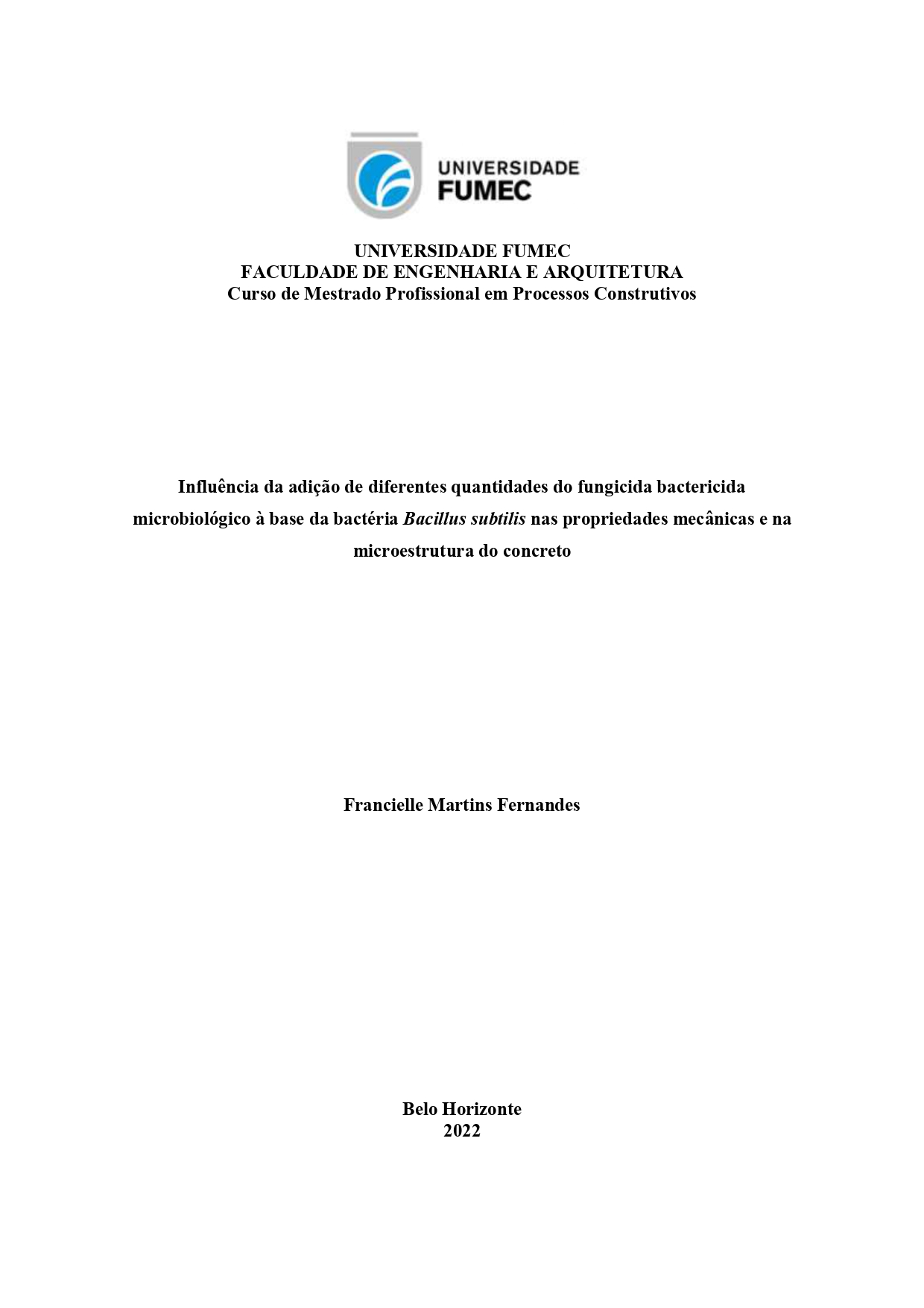Influência da adição de diferentes quantidades do fungicida bactericida microbiológico à base da bactéria Bacillus subtilis nas propriedades mecânicas e na microestrutura do concreto

Visualizar/
Data
2022Autor
Fernandes, Francielle Martins
xmlui.mirage2.itemSummaryView.MetaData
Mostrar registro completoResumo
A elevada tendência à fissuração do concreto o torna susceptível ao contato com muitos agentes internos e/ou externos, que podem agir e gerar manifestações patológicas na estrutura. Neste contexto, o estudo do fenômeno de autocura do concreto por meio de bactérias vem se destacando. As bactérias do gênero Bacillus subtilis em contato com uma fonte de cálcio podem precipitar cristais de carbonato de cálcio, preenchendo as microfissuras existentes nos materiais cimentícios. O objetivo deste trabalho foi analisar
a influência da adição de 500 mL e 250 mL do fungicida bactericida microbiológico à base da bactéria Bacillus subtilis na resistência à compressão axial e à tração por compressão diametral e na microestrutura do concreto. Para a confecção do bioconcreto foi utilizado o traço de 1:2,538:1,102, com substituição de 30% do agregado graúdo pela argila expandida impregnada com bactéria e relação água/cimento de 0,5 para 500mL do produto Serenade e para 250mL a relação a/c foi de 0,545. Após o tempo de cura, os corpos de prova (CP) do bioconcreto foram submetidos ao ensaio não destrutivo (por
meio de ultrassom), os quais apresentaram bons resultados, e aos testes experimentais destrutivos para determinar a resistência à compressão e à tração por compressão diametral. A resistência à compressão média dos CP´s do bioconcreto com 500 mL de Serenade foi 27,97 MPa, o que corresponde a um resultado de, aproximadamente, 20% superior dos CP´s de bioconcreto com 250 mL de Serenade. Já a resistência à tração por compressão diametral média dos CPs contendo 250 mL do fungicida bactericida
biológico foi de 8,76 MPa, correspondendo a um resultado de aproximadamente, 17% superior dos CP’s que continham 500 mL do Serenade. Posteriormente, as amostras rompidas secas e umedecidas com água foram analisadas por meio do Microscópio Eletrônico de Varredura (MEV). Observaram-se alguns cristais de carbonato de cálcio, especialmente nos fragmentos úmidos. Por fim, os corpos de prova do concreto bacteriano tiveram um bom desempenho nas propriedades analisadas. The high tendency of concrete to crack makes it susceptible to contact with many internal and/or external agents, which can act and generate pathological manifestations in the structure. In this context, the study of the phenomenon of self-healing of concrete by means of bacteria has been highlighted. Bacteria of the genus Bacillus subtilis in contact with a source of calcium can precipitate calcium carbonate crystals, filling the existing microcracks in cementitious materials. The objective of this work was to analyze the influence of the addition of 500 mL and 250 mL of the microbiological bactericidal fungicide based on the bacterium Bacillus subtilis on the strength of axial compression and tensile strength by diametral compression, and on the microstructure of concrete. For the preparation of the bioconcrete, a mixture of 1:2,538:1,102 was used, replacing 30% of the coarse aggregate by the expanded clay impregnated with bacteria and,
water/cement ratio of 0,5 for 500mL of the Serenade product and for 250mL the ratio w/c was 0,545. After the curing time, the specimens of the bioconcrete were submitted to the non-destructive test (using ultrasound), which showed good results, and to the destructive experimental tests to determine the compressive and tensile strengths by compression. diametral. The average compressive strength of the specimens of bioconcrete with 500 mL of Serenade was 27,97 MPa, which corresponds to a result of approximately 20% higher than the specimens of bioconcrete with 250 mL of Serenade. The average
diametrical tensile strength of specimens containing 250 mL of the biological bactericidal fungicide was 8,76 MPa, corresponding to a result of approximately 17% higher than the specimens that contained 500 mL of Serenade. Subsequently, the ruptured samples, dried and moistened with water, were analyzed using a Scanning Electron Microscope (SEM). Some calcium carbonate crystals were observed, especially in the wet fragments. Finally, the bacterial concrete specimens had a good performance in the analyzed properties.
